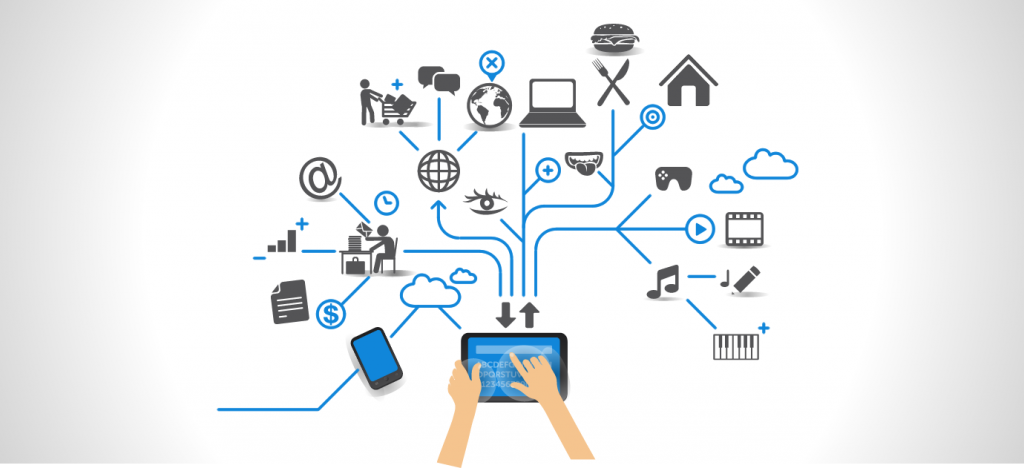We are so used to interact with the Web in our daily routines that we just sometimes forget, or are not even aware, that there is a huge world making it happen. Every time that we check our social media feeds or if we want to send a message, a document or a simple image, that information, will be transmitted through signals and networks devices that eventually will take it to its destination. This infrastructure and communication technology has been growing and improving in giant steps out of necessity. We were used to just have PCs connected to Internet but the mobile market changed everything. In only one year (2015), more than half billion of mobile devices were added to the network.
Nowadays, when we need to send or receive something out of the Web, we use our smartphones, tablets or PCs for it. Those are our hubs and only interactions to Internet. But hey, things are getting crazier now thanks to the Internet of Things (IoT). Gartner estimates that in 2020, there will be 20.8 billion ¨things¨ connected. So what are those ¨things¨? This is a scenario to introduce this technology trend.
Let´s say that you are back home, you are starving, but a friend told you about a great new recipe so it´s time to try something new. You would need to find a recipe online, get the food from the market (and if we go more high end, use our supermarket app to order it) and then get the job done.
In an IoT environment, your cellphone will learn through the conversation with your friend that you’d like to give a try to a new meal and sent that data to the cloud. This triggered an automatic call to your refrigerator which through sensors and a learn inventory from your last market purchases, will know what ingredients you already have and what is missing. It will create a list to your supermarket store and order them already. Your recipe needs a hot oven so it would be automatically turned on 20 minutes before your arrival. You are at home, the missing ingredients are waiting at your door and you are ready to start!
Put a Network Interface Card and a sensor on all ¨things¨ you can imagine and that´s IoT. So when we talk about ¨things¨ we indeed refer to any ¨thing¨ you can imagine! All that can be ¨sensed¨ can be transformed into data to be analyzed and perform an action after it. Current development kits and technologies like Rasperry Pi’s make IoT accessible to everyone. Sites like Smartliving Docs teach you how to do this at your home so your coffee machine can have you one cup ready for your delight only those cold days depending on what temperature wheater.com reported that day.
We can also think bigger and see the impact of IoT creating smart cities. Projects like City24/7 integrates live information from transportation systems, government programs and local business and makes this information accessible to New York citizens on how they can reach certain destination easier depending on the current hour and roads status, they can also learn about events of interest to them that could be close to them that can be accessed through Smart Screens and WiFi spots located all around the city. It can also provide police and fire departments a citywide sensing.
Other programs have been focusing on tackling down traffic congestion, finding real-time solutions to detect best routes and avoid possible collisions before they happen.
Of course, these are solutions to save money and improve life quality, but it can also be used to save lives, and even species. For example, white and Black Rhinos species are being decimated in a rate of 3 rhinos per day due to illicit animal pouching in South Africa. Cisco and Dimension Data Smart+Connected Conversation system senses all human and animal activity across the South African Rhinos habitat to detect any possible threats to the rhino species informing their staff immediately and mitigating their activities before they can reach the animals. This system is pretended to be used to protect many other vulnerable animals across the world from human activity.
So even if it´s just to make your toaster inform you that it has finished or if it is a complete electric lights sensing network to save energy, IoT puts the whole world to be analyzed and provide a solution for problems that require distributed data inputs and outputs. There are still some other topics on the air like the possible Security breaches but there are multiple IT companies and people working on it. So knowing the power of IoT, knowing that you can get all the information in your environment and program a system to solve from trivial to relevant problems…how would you think that something as simple as knowing the toilet usage could help save lives from other countries? Or what other ¨things¨ could be monitored to get rid of the most important problems in your community?
Special thanks to César G. López Zamarripa Sr. Security Engineer at Cisco Systems for collaborating with ScreenIT in this post.
By: Arce








